Light Kits
There are many choices of ceiling fan light kits.
- Branched, or stemmed, light kits usually come with 3 or 4 “arms” and can either point up toward the ceiling fan or down toward the floor.
- Bowl
light kits can either be directly attached to the ceiling fan housing
(i.e., integral), or attached below the fan. Bowl and shade designs
range from clear to alabaster, crystal, or tiffany - the fancier the
glass design, the more expensive. Nearly all ENERGY STAR qualified
ceiling fan light fixtures use bowl lighting. - Uplight
designs are also becoming more popular. where the light kit sits on top
of the housing and point up toward the ceiling, casting a softer light
throughout the room
Ceiling fan light kits can be purchased three different ways:
(1) integrated into the fan, (2) included with the fan at the time of
purchase, or (3) sold separately. Many of the light kits that are sold
separately are “universal,” meaning that they can be used on a number
of different fan models. Similarly, most ceiling fans are light kit
adaptable. However, there are many cases where compatibility is only
between light kits and ceiling fans under the same brand. Information
regarding light kit/ceiling fan compatibility should be found on the
product packaging.
Remote and Wall Controls
Standard
controls for the ceiling fan motor include a pull chain attached to the
housing (two if lighting is included), and a motor reversing switch on
the lower, or switch, housing. However, many manufacturers offer remote
or wall controls either sold with the model or as an accessory. Most
ceiling fans have a 3-speed switch in the housing and as such, most
ceiling fan wall controls complement this set-up. When choosing a wall
control for a fan/light combination, make sure to choose one that
operates each function separately and can operate the fan at 3 or 4
distinct speeds. Using a conventional dimmer switch to run the fan
could cause the ceiling fan motor to hum. When you choose an ENERGY
STAR qualified fan with lighting or an ENERGY STAR qualified light kit,
and you wish to use it with a dimmer, make sure the packaging indicates
that the lighting is dimmable.
Be sure to look for controls
that match up with your ceiling fan: maximum amps, number of speeds,
total lamp wattage, and brand. Some of the remote and wall controls
work with a number of different ceiling fan brands; however, there are
some remotes that should only be used with specific brands. Check with
the sales associate and/or the product packaging if purchasing the
controls separately.
Purchasing Choices
Ceiling
fans are sold in many different distribution channels: lighting and
builder showrooms, national retail chains, hardware stores, and
electrical distributors. Showrooms offer consumers many different
brands, finishes, blade types, and light kit options. Here, each
consumer may essentially design his or her own fan. Retail chains and
hardware stores usually offer a number of different choices in
completed fans, with or without lighting, and light kits.
